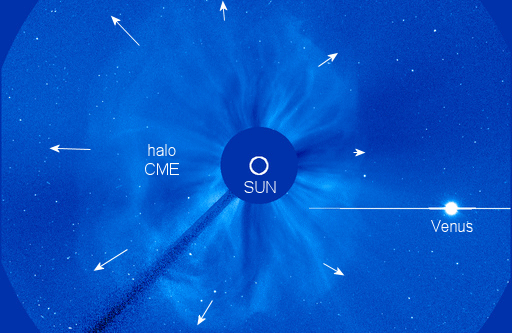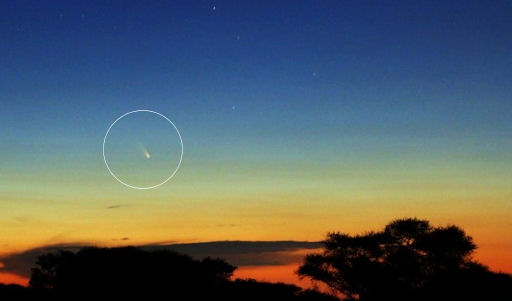They came from outer space--and you can have one! Genuine meteorites are now on sale in the Space Weather Store. | | |
SOLAR ACTIVITY INCREASES: Both sides of the sun are active today. On the farside, an explosion commencing around 0400 UT hurled a massive CME into space. On the Earthside, sunspot AR1686 unleashed an M1-class solar flare at 0754 UT: movie. This uptick in global solar activity could herald a period of stormier space weather in the days ahead. Stay tuned. Solar flare alerts: text, voice.
FARSIDE EXPLOSION: An active region on the farside of the sun exploded during the early hours of March 5th, hurling a bright CME into space. Cameras onboard the Solar and Heliospheric Observatory (SOHO) recorded the expanding cloud:

NASA's STEREO-Behind spacecraft is stationed over the farside of the sun, directly above the blast site. An extreme UV telescope onboard the spacecraft recorded a movie of the explosion. The responsible active region will rotate onto the Earthside of the sun in less than a week, which means geoeffective solar activity is in the offing. Solar flare alerts: text, voice.
Realtime Space Weather Photo Gallery
COMET PAN-STARRS AT SUNSET: Observers in the southern hemisphere are getting a good view of Comet Pan-STARRS (C/2011 L4). It appears in the western sky just after sunset, an easy target for the naked eye and a wonderful sight through binoculars or a small telescope. Kosma Coronaios sends this picture, which approximates the naked-eye view, from Limpopo Province, South Africa:

"PanSTARRS was a beautiful sight over the South African bushveldt once again," says Coronaios. "Only a few more days left before it will disappear for us and become a northern hemisphere target. "
Several important dates are approaching. On March 10th, Comet Pan-STARRS makes its closest approach to the sun (0.3 AU). At that time, solar glare might make it difficult to see even as the nucleus vaporizes and brightens. O March 12th and 13th, the comet will reappear in the sunset sky--this time in the northern hemisphere not far from the crescent Moon; think photo-op! Light curves suggest that the comet's brightness will peak near 2nd magnitude, similar to the stars of the Big Dipper. Check the realtime comet gallery for the latest images.
More about Comet Pan-STARRS: NASA video, 3D orbit, ephemeris, light curves.
Realtime Comet Photo Gallery
Realtime Aurora Photo Gallery
Realtime Noctilucent Cloud Photo Gallery
[previous years: 2003, 2004, 2005, 2006, 2007, 2008, 2009, 2011]
Potentially Hazardous Asteroids (
PHAs) are space rocks larger than approximately 100m that can come closer to Earth than 0.05 AU. None of the known PHAs is on a collision course with our planet, although astronomers are finding
new ones all the time.
On March 5, 2013 there were potentially hazardous asteroids.
Notes: LD means "Lunar Distance." 1 LD = 384,401 km, the distance between Earth and the Moon. 1 LD also equals 0.00256 AU. MAG is the visual magnitude of the asteroid on the date of closest approach. | | The official U.S. government space weather bureau |
| | The first place to look for information about sundogs, pillars, rainbows and related phenomena. |
| | Researchers call it a "Hubble for the sun." SDO is the most advanced solar observatory ever. |
| | 3D views of the sun from NASA's Solar and Terrestrial Relations Observatory |
| | Realtime and archival images of the Sun from SOHO. |
| | from the NOAA Space Environment Center |
| | the underlying science of space weather |

